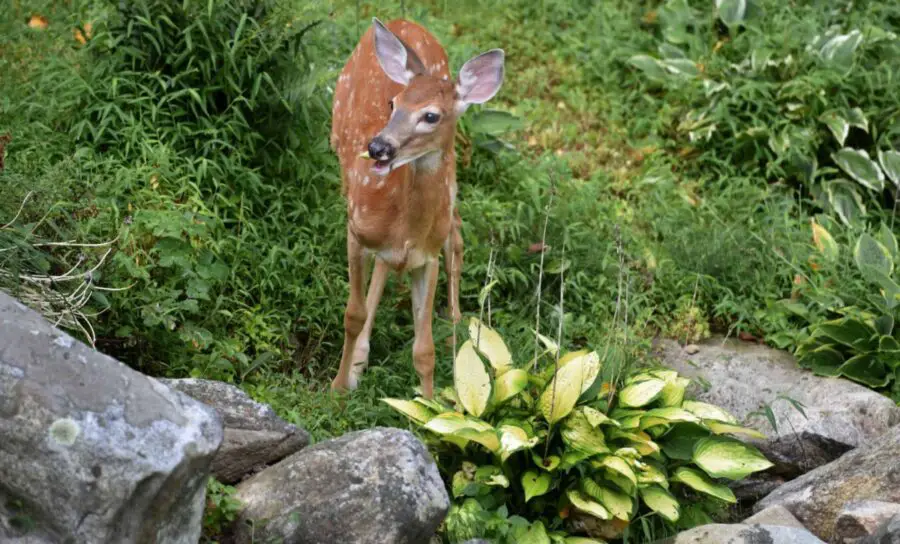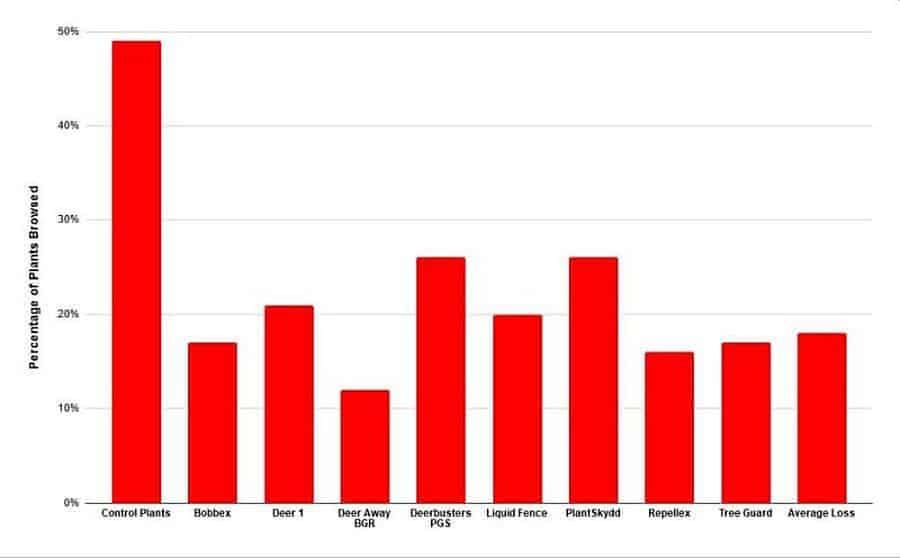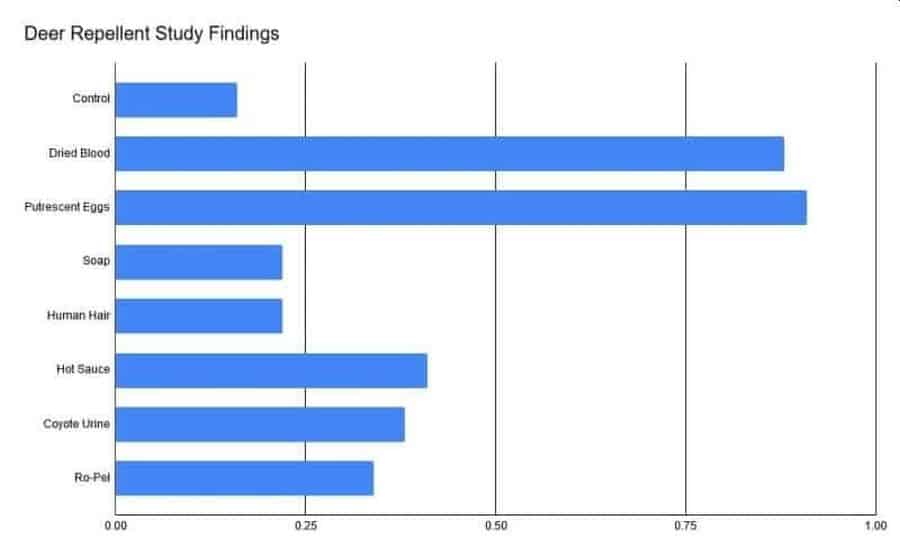Do deer repellents work to keep the deer out of your hostas? This comparison of deer repellents will let you know which ones do and don’t work.
For hosta growers, finding deer a repellent for hostas that works can be a challenge. The good news is that chemical deer repellents may not be 100% effective, but they come close.
Chemical repellent granules, sprays, sprinklers, scent stations, and noisemakers are all very effective for scaring the deer away, and research supports this claim. However, a starving deer can bypass them and eat your hostas.
Do you want to know which are deer repellents for hostas that work? I know I spend a lot of time fussing over my plants and I was determined to protect them from those pesky deer.
With a lot of research (and a few tears), I’ve come up with a master list of chemical deer repellent, and I’ll share them with you. Read on to find out more!
What Are Commercial Deer Repellents
Commercial deer repellents are products that use taste, conditioned avoidance, fear, or pain to teach the deer to stay far away from them. The fear-inducing deer repellents have compounds in the chemical makeup that can release a sulfurous odor.
This odor mimics what a deer would smell if they came across predator urine, garlic, or meat proteins. They will avoid this spot, as it triggers their natural fear response.
Unpleasant taste and conditioned avoidance are two products of using chemical deer repellents.
For example, if they eat your hostas two or three times and experience gastrointestinal distress or sickness, it conditions them to avoid these plants as they associate it with bad things.

Bitter deer repellents trigger unpleasant taste for the deer, but many will continue eating if there aren’t more severe consequences. Just like many people don’t mind bitter tastes, while others avoid them like crazy.
The active ingredients in chemical deer deterrent like allyl isothiocyanate, ammonia, or capsaicin cause unpleasant side effects like irritation or mild pain when they come into contact with the mucous membranes in the deer’s nose, eyes, mouth, or stomach.
This quickly wards the deer away from your hostas once they associate eating the plants with these side effects.
A Comparison of Commercial Deer Repellents
To expand on the different types of chemical deer deterrent that are available, the following table will highlight the product, active ingredients, and the mode in which it wards deer away.
I found this fascinating when I started digging into the different deer repellents, and the U.S. Department of Agriculture Forest Service provided a helpful list.
Thiram—This is a fungicide that farmers use to prevent crop damage in the field. It’s also useful to protect harvested crops from deteriorating during transport and storage.
Capsaicin—This is the active component you find naturally occurring in chili peppers. This chemical irritant can cause a burning sensation on contact.
Putrescent Whole Eggs—These are cracked eggs that the company deemed unfit for human consumption, and they give off a very foul odor.
Garlic Oil/Juice—A powerful smell that can linger around wherever you pour it.
Denatonium Benzoate—The single most bitter chemical compound known and currently available
Meat Meal/Fatty Acid/Animal Protein—Releases the smell of dead or dying animals to scare deer away.
Predator Urine—Coyote urine is very effective in warding deer away, as deer are prey animals and will avoid coyotes.
Disulfides—Releases a very strong sulfur-like smell.
D-limonene—Can cause digestive upset and nausea if the deer ingest plants that have it on them.
As you can see with this table, the chemical deer deterrents have a host of active ingredients, and each ingredient can trigger a different avoidance mode when the deer come across it.
This is great if you have pets around and you’re not sure what the deterrent would do if they accidentally got into them, so you can better tailor your choices to keep everyone safe.
Personally, I like a mix of different repellents because I have some stubborn deer around who find my hostas irresistible.
However, I do favor deer repellents with putrescent whole eggs because they have an extremely strong odor that does a great job at keeping the deer well away. Liquid Fence is a great example of a commercial-grade deer repellent that uses this ingredient.
A winter browse deer test put nine different commercial deer repellents to the test to see which one would work best against predators.
This was a three-year study that took ornamental plants and shrubs and applied different commercial deer repellents each spring before recording the results.
They grouped all the commercial repellents together and compared their plants to the control plants to see which one was the most effective.
The following table will list the average percentage of all plants browsed over those three years so you can see which one was most effective.

The Deer Repellent Study
A 16-day trial sought to answer the question, “Do deer repellents work?”
To set up the study, they used eight matching dowel rods with a nail on the top, 128 3-inch corn cobs (set out at eight per day over the 16-day experiment), and seven types of deer repellent. They used dried blood, putrescent eggs, soap, human hair, hot sauce, coyote urine, and Ro-Pel.
Ro-Pel—Bitter taste deterrent
Putrescent Eggs—Liquid Fence
Dried Blood Product—Espoma
Coyote Urine Pellets—Shake-Away
Soap—Ivory dish soap at a 10% concentration
Hot Sauce—Tabasco at a 10% concentration
Human Hair
Control—no deterrent
Each dowel with a corn cob attached to the top of a stake that was driven into the ground 10 feet apart in two rows. Each dowel got one of the deterrent types, and one had a plain corn cob with no deterrent.
Every day, they’d go and observe/record the results, and they’d switch the dowel placement every two days.
At the end of the study, each deterrent got a value of 0, 0.5, and 1 to help determine how effective every repellent is. They found putrescent eggs were the biggest deterrent, with an effective rate score of 0.91, and dried blood followed at a 0.88 effectiveness score.
The human hair and soap deterrents were the least effective with a 0.22 rate, and they ate the control corn cob 84% of the time.
This proves that commercial deer repellents do a better job at keeping the deer at bay than homemade deer repellent, like deer repellent soap.

Three Deer Repellents That Work
Now that you see the two study results showing which ingredients work, I’ll show you three great deer repellents that incorporate these ingredients.
If you’re like me and have stubborn deer, go ahead, try all three and see which deer repellent for hostas does the best job of protecting your hostas.
1. Liquid Fence
Liquid Fence is a very potent deer repellent that uses putrescent eggs as the main ingredient. Right when you put it on the ground around your hostas, you’ll notice a very strong odor. Luckily, this odor fades as the product dries.
It comes back every time water or liquid hits it. Apply it all year round for the best results, and the rain won’t wash it away. This can save you money (and I love saving money when I can) because you won’t constantly be reapplying it.
It works well on rabbits too, and you can pick from a granular form, ready to spray, or concentrated mix you dilute down. It comes in 14 size options.
Pros:
Uses scent to deter deer
Resistant to rain
Can use all year round
Cons:
Have to re-spray when new growth emerges
Have to reapply regularly
Repellex Deer and Rabbit Repellent
Repellex scored high on the browsing study as being one that used both scent and taste to keep deer and rabbits away from the plants.
The principal ingredient is dried blood, and it uses a mix of oils to create a powerful scent that sticks to your plants and lingers long after you apply it. It’ll last up to three months while surviving the rain and wet conditions, but you can’t put it on any plants you plan to eat.
The oils can sink down in the plant and infuse the taste into it to make it unsafe to eat. All you have to do is spray this natural formula on and let it go to work.
Pros:
All-natural ingredients
Uses taste and smell to scare deer off
Easy to apply
Cons:
Can’t apply it to edible plants
Have to reapply after each rain
Bobbex Concentrated Deer Repellent
Bobbex repellent uses a combination of fish by-products, garlic, and fertilizer to create something that looks and smells nasty to deer.
Dilute it before you use it, but you can spray it right on and around your hostas without burning them. It’s safe to use around pets, but the odor takes a good while to vanish once you spray it.
Reapply it every 10 to 14 days during the active growth season, but you can cut back to every four or eight weeks in the winter. There are several sizes to choose from, and it has explicit instructions on how to dilute it.
Pros:
Sticks to your plants
Easy to dilute
Available in several sizes
Cons:
Reapply every 10 to 14 days
Expensive for larger areas
The Importance of Rotating Deer Repellents
No matter which type of deer repellent you choose, the deer will eventually get used to it, go through it, and eat your hostas. If you forget to reapply your repellent when you’re supposed to (and we all get busy and forget) deer will walk right by it.
Consider periodically rotating the brand of commercial deer repellent you use to protect your hostas. Just make sure each deer repellent uses different ingredients.
For example, Liquid Fence uses egg solids and garlic as a base, and you could rotate that with Plantskydd because it uses fatty acids and meat meals for the base.
Doubling Up Repellents
To create a strong line of defense for your hostas, double up on your deer repellents. Doubling up can close any coverage gaps you have while your hostas grow to better protect them.
For example, you could use a granular repellent like Liquid Fence Granules and a spray like Plant Pro-Tec.
If you just used the spray, you’d have to reapply it after every new growth spurt or rain. Combining the two gives you more leeway for coverage because the granules are still around after the spray fades.
You could also look into getting deer repellents that are combinations of different repellents. A few of those include:
Not Tonight Deer—Combination of whole egg solids and Montok pepper concentrate
Dr. T’s Deer Blocker—Combination of putrescent whole eggs, garlic, and capsaicin
Deerbusters Deer Repellent Sachets—Combination of meat meal and red pepper
You could use these three in spray form and combine them with predator urine granules or ammonium soaps like Hinder or Coyote Urine Sachets. This will give you more even coverage and help you avoid coverage gaps if it rains or the hostas grow.
Video: How to Keep Deer from Eating Your Plants
Frequently Asked Questions
Does Deer Repellent Really Work
As long as you apply the deer repellent correctly and follow the instructions, yes. A high-quality commercial deer repellent can be effective for keeping deer away from your plants. You might have to try out a few types before you find the one that works on your deer.
What Are the Most Effective Deer Repellents
As you can clearly see by the studies we touched on earlier, deer repellents with putrefied eggs, garlic oils, and dried blood do best at scaring deer away. They have a strong scent that clings to the plants and makes them unappetizing.
What Is a Simple Homemade Deer Repellent
If you want to try a homemade deer repellent, mix three tablespoons of hot sauce with three tablespoons of minced garlic and three raw eggs.
Blend everything and pour it into a spray bottle. The eggs will help the solution stick to your plants, and the ingredients have a strong smell and taste deer don’t like.
Video: How to Keep Deer from Eating Your Plants
Final Thoughts
If you have a problem with deer eating your hostas, don’t fret over it. While there’s no such thing as a deer-proof hosta (unless it’s fake), commercial deer repellents have a very high effective rate.
Try different types of deer repellent like Liquid Fence, Repellex, or Bobbex and see which one does the best job of convincing the deer to keep your hostas unscathed. Get it right and you’ll have lush and gorgeous hostas all year long while the deer look on in envy.